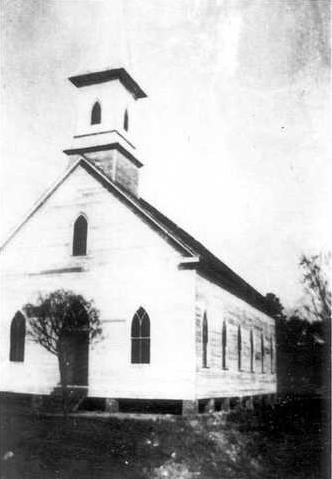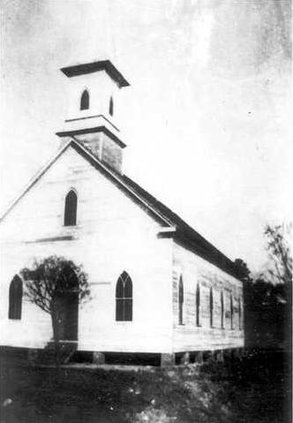Grace Lutheran Church in Stillwell was organized on Jan. 24, 1902.
During the winter season, members of Jerusalem Lutheran Church living on the north side of Ebenezer Creek were kept away from church by high waters. These waters overflowed the banks of the Savannah River and lands adjacent thereto for miles around. This made attendance at services practically impossible as transit to the church had to be made over a bridge and long causeway inundated by floodwaters or by means of paddling a boat. Due to this condition, the people were deprived of church services and the children the benefits of Sunday school. Rev. N.D. Bodie, taking note of these conditions, set to work to remedy them as much as possible.
In the year 1899 or 1900, the first Sunday School was begun in the schoolhouse in Stillwell with David Dasher II as Superintendent. The Sunday School prospered under his leadership.
In 1902, the South Bound Land and Improvement Company came forward with a proposition to donate two lots at Stillwell for a church, proposed to any religious group that would accept and build a church. The offer of land in the new town along a railroad furnished the necessary incentive for the location of the church building. On Dec. 15, 1890, the Southbound Investment Company conveyed to William R. Gnann, C. Bertody Gnann, and Dan G. Simmons lots number 14 and 24 of a subdivision made by Pursey Sugden. There was a stipulation in the gift of the lots, namely, that a church be constructed within a reasonable period, or the donation would be withdrawn.
A temporary chairman and secretary were elected at a meeting on Jan. 16, 1902. A committee was appointed to secure membership. On Jan. 24, 1902, the Membership Committee reported 11 charter members. The following were formally elected: Elders — W. C. Rahn and C. B. Gnann; Deacons — A. O. Gnann and J. J. Simmons; chairman of the congregation W. C. Rahn and secretary A. O. Gnann. The chairman appointed a building committee composed of: C. B. Gnann, W. R. Gnann and D. G. Simmons.
Charter members included: William C. Rahn Sr., Matilda V. Rahn, Cletus Bertody Gnann, Effie Groover Gnann, Alvin Osgood Gnann, Lena Exley Gnann, William Randolph Gnann, Carrie Gnann, James J. Simmons, Lottie E. Simmons, Dan G. Simmons, Emma Simmons, Nella Walton Gnann and Rosa Mae Gnann.
The church was begun in March of the same year. On Oct. 9, 1902, the Rev. Dr. M. J. Epting, D.D. of Savannah, president of the Georgia Synod and the church’s first pastor, Rev. N.D. Bodie, laid the cornerstone. The building was situated mainly on lot 14 and faced south. It had a tall steeple, which contained a large bronze bell that was used for formal occasions. The construction was of wood and in the Gothic style, and it had stained glass windows. The exterior was painted white, and was completely ceiled. Local carpenters made the pews in the style of those then in use at the Methodist Campground Tabernacle in Springfield. There was sufficient lighting, which progressed from the original kerosene lamps to electric. A pulpit and lectern were purchased and in 1905 an organ was purchased with funds raised by the Sunday school.
The building was struck twice by lightning. The first time was on Aug. 30, 1908, when the tower was torn off. The second time lightning struck was on July 15, 1921. This time the church burned. Faulty wiring may have been the cause as electric lights had been installed. Most of the men were away and very little help was available. The members were fortunate to save the altar furnishings, organ, Bible and hymnbooks.
Plans were made to rebuild. A congregational meeting was held Sept. 5, 1921, in the Stillwell Schoolhouse with Walter A. Gnann acting as chairman. Secretary Alvin O. Gnann recorded that the decision was made that all male members of the congregation were designated as a building committee. A contract was made with the Tebeau brothers, Jim and Robert. After a lapse of about 14 months, the second building, made this time of brick, was begun Sept. 25, 1922. Services were held a little more than two years after the burning of the first church building.
The cornerstone of this building was laid on Oct. 29, 1922. At this service, Rev. N.D. Bodie made the address. The Rev. Dr. T.W. Shealy assisted him. The church building was completed free of debt and was formally dedicated on Aug. 31, 1930, by the Rev. Dr. Walter A. Reiser, D.D., President of the Synod. Rev. L.O. Dasher was pastor at the time.
The Grace congregation celebrated its 60th anniversary on July 1, 1962, rather than in January due to unfavorable weather. At this time, due to death and member transfers to other congregations, the baptized membership was 41.
On Sunday, April 5, 1964, Grace Evangelical Lutheran Church was formally merged with Holy Trinity Lutheran Church, in Springfield. The pastor of Holy Trinity, Rev. Clarence B. Adderholdt, held the last full service of Holy Communion at Grace. The last service held in Grace Lutheran Church was the May 1973 funeral service of the last charter member, Alvin O. Gnann. Rev. E.B. Keisler assisted in this service and was the minister who had preached the first sermon in this church building in January of 1924.
Pastors who served at Grace were: Rev. N.D. Bodie, Rev. H.W. Jeffcoat, Rev. Y. Von A. Riser, Rev. P. E. Shealy, Rev. J. B. Haigler, Rev. E. B. Roof, Rev. E.B. Keisler, Rev. J.C. Wessinger, Rev. L. O. Dasher, Rev. C. E. Seastrunk, Rev. H. J. C. Lindler (served twice), Rev. B.H. Koch, and Rev. Dr. C. J. Shealy, D. D.
This history up to this point was written by Alvin O. Gnann; and prologue and epilogue by Ernest Gnann in 1976. Lena R. Shearouse Nizzi completed the history in June of 2002 which was published in the 90th History of Holy Trinity Lutheran Church.
After the funeral of Alvin Gnann, the church was torn down. The pews are now in the Effingham Chapel of Thomas C. Strickland and Sons Funeral Home, and the former members were pleased these pews stayed in use in our community. Grace’s organ was purchased by Essie Gnann and is now the property of a member of her family. The building was sold for materials to construct another church, the furnishings were given to other churches and the property was sold. Stillwell Cemetery off Cletus Gnann Road became property of Holy Trinity Lutheran Church in a legal trust agreement with trustees known as the Stillwell Cemetery Association who oversee its care and upkeep. In the 1964 merger, Holy Trinity Lutheran Church received members who are still active today in the Springfield congregation.
This was compiled and the last paragraph written by Susan Exley of Historic Effingham Society. If you have photos, comments or information to share, contact Susan Exley at 754-6681 or email her at: hesexleyherald@aol.com





